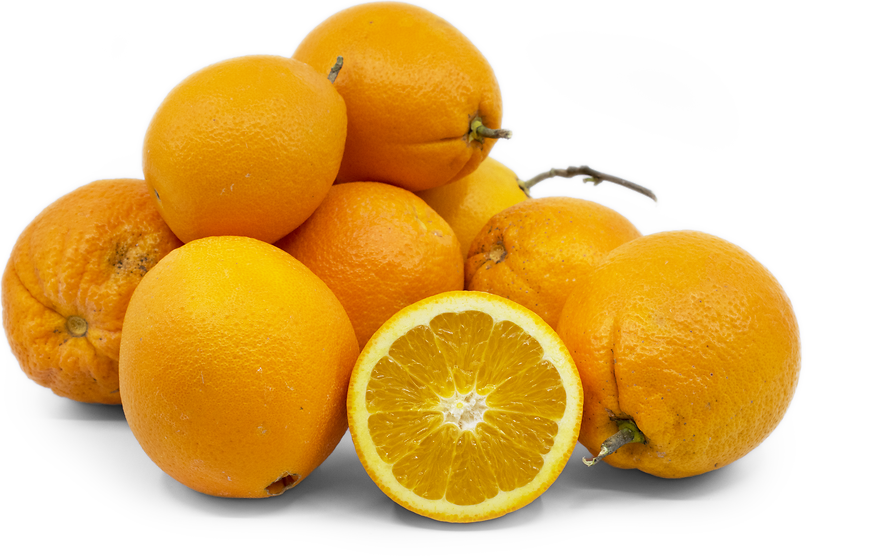


Navelina Oranges
Estimated Inventory, lb : 0
Description/Taste
Navelina oranges are medium to large in size and are spherical, obovoid, to slightly pear-shaped with a small rounded depression, also known as a navel, on the blossom stem end. The medium-thin rind has a vibrant red-orange hue at maturity and is smooth with a pebbled appearance due to the presence of many oil glands that contain fragrant essential oils. Underneath the surface of the rind, the white pith is spongy, compact, and easily removed from the flesh. The pale orange-yellow pulp is soft, juicy, seedless, and divided into 10-12 segments by thin white membranes. Navelina oranges are aromatic and contain a low amount of acidity, creating an overall sweet flavor.
Seasons/Availability
Navelina oranges are available in the winter through early spring.
Current Facts
Navelina oranges, botanically classified as Citrus sinensis, are a variety of sweet orange that grows on semi-dwarf, evergreen trees and belongs to the Rutaceae or citrus family. Also known as Smith’s Early navel, Washington Early, and Dalmau in Portugal, the name Navelina refers to the small navel or hole on the blossom end of the fruit, which is similar in appearance to a human navel or belly button. Navelina oranges are an early maturing variety that is favored for its sweet taste and substantial juice. The oranges are predominately cultivated in Spain, but they are also grown in North Africa and other Mediterranean regions.
Nutritional Value
Navelina oranges are an excellent source of vitamin C and potassium and also contain fiber, magnesium, vitamin A, and some vitamin E.
Applications
Navelina oranges are best suited for both raw and cooked applications, but their sweet flavor is showcased when used fresh, out-of-hand. Easy-to-peel, Navel oranges can be segmented and tossed into green salads, mixed into fruit bowls, blended into smoothies, chopped into salsa, topped over vanilla ice cream, garnished over cooked meats, or served over grain bowls and yogurt. The rind can also be used to flavor baked goods such as cakes, zested to create scented salts and sugars, or used as a flavoring for syrups, curds, and doughs. In addition to fresh applications, Navelina oranges can be roasted or poached to create a sweet dessert. Navelina oranges pair well with black rice, quinoa, couscous, curried cauliflower, tarragon, cilantro, balsamic vinegar, cranberries, strawberries, bananas, coconut, pomegranate seeds, beet, parsnip, radish, kale, red bell pepper, Greek yogurt, almonds, pecans, pine nuts, pistachios, and meats such as poultry, pork, and steak, shrimp, and scallops. The fruit will keep up to a week at room temperature and up to two weeks when stored in the refrigerator.
Ethnic/Cultural Info
Oranges are an important part of the culture and economy of Spain, which is one of the largest citrus producers in Europe. Navelina oranges, along with other varieties, are primarily grown in Spain for fresh eating and exporting, but the oranges are also juiced daily at cafes, restaurants, and supermarkets and consumed as a sweet drink. In addition to freshly squeezed drinks, the juice is added to cocktails such as mimosas, and the dried orange peels are used to flavor an array of Spanish sweet orange wines. When traveling throughout the country, it is also common to see orange trees lining the city streets as urban landscape, with some cities containing over 40,000 citrus trees.
Geography/History
Navelina oranges were first discovered growing as a natural mutation in California and in 1910, they were selected as a budsport for the Citrus Research Center in Riverside, California. Originally named Smith's Early navel by the research center, Navelina oranges were exported to the Valencian Institute of Agrarian Research in Spain in 1933 where it went through many trials and selection. In Spain, the variety was renamed to Navelina, and in 1990 it was reintroduced back into California. Today Navelina oranges can be found at local markets in Europe, Northern Africa, Australia, and the United States.




